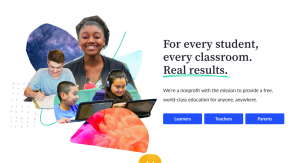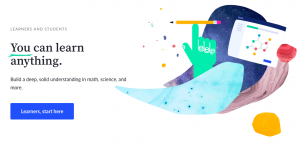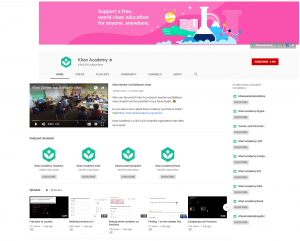
In the Khan Academy homepage, learners are greeted by a slogan “You can learn anything” (Khan Academy). This was also the banner I chose from my last post, since I thought it perfectly captured the essence of Khan Academy. Amongst all other online educational platforms, it is without a doubt that Khan Academy is one of the most widely used all over the world. It was official established in 2009, and has kept on growing ever since. Its growth is not limited to the number of users, but also the amount and quality of online learning content.
In my previous post, I shared how excited I was about the growth of Khan Academy. I also briefly wrote about its history, as well as some specific principles that has made it the success it is today. For this post, my research aim is to further explore the success of Khan Academy by analyzing the main guiding themes that are followed by the website. After reading through several articles tackling the progress and development of Khan Academy, and how it is used in different learning environments, I found that there are major themes that make up the foundation of Khan Academy. These themes, although practiced in online platforms, are not limited to such environments. In fact, these can also be applied to any learning environment, in order to assure the educator that his/her students are maximizing their learning.
An Overview of Khan Academy
Before exploring the principles of Khan Academy, I will first provide a short background of the website. The mission of Khan Academy is “to provide a free, world-class education to anyone, anywhere. (Khan Academy).” It is a non-profit organization that aims to deliver basic education needs to children around the world, as well as supplement higher education needs of students who are having difficulties in school or who need extra support in certain topics. Not only does Khan Academy cater to the needs of students, they also provide materials and resources to teachers. In the platform, teachers have the opportunity to find appropriate content, track the progress of their students, assign exercises online, and collaborate with other teachers around the world. Moreover, Khan Academy also enables parents to assist in their child’s learning by the creation of parent accounts that can also monitor learning progress.
The Concept of the Flipped Classroom
The founder of Khan Academy, Sal Khan, believes that there is no need for students to be segregated according to their age (Parslow 1). Usually, students are placed in grade levels on the basis of chronological age. Although this has been standard practice for schools for decades, research has established that this is not the best approach to education. Children, even though they are of the same age, have different and varied learning capacities and abilities. A child who has grown up in a home environment that speaks mainly English may excel in the English subject, while a child who has grown up in a home that speaks another language may find it difficult to keep up in English class. Hence, the practice of dividing children into grade levels based on age fails to take into consideration the cultural and societal backgrounds of children. Of course, it is quite idealistic to consider all these aspects, but nevertheless, it is important to remember these principles when it comes to a child’s education. Due to these reasons, Sal Khan has proposed the concept of the “flipped classroom” (Parslow 1). This concept acknowledges the differences of learning speeds of children, and allow children to learn at their own pace. Moreover, the focus of learning shifts from the teacher to the student, where the teacher is no longer he main source of information, but only a guide of learning. Parslow concludes that the flipped classroom approach to education has positive effects to learning (1). The concept of the flipped classroom is interesting, since it is a departure from traditional education. Moreover, it has shown positive results in the form of higher test scores and greater overall comprehension.
Studies that have explored flipped classrooms have shown that despite its positive results, such an approach also has its difficulties. One is that teachers may not be able to be equipped enough to handle technological advances in education (Zengin 89). The solution to this is to train and educate teachers on how to maximize such technologies, while at the same time, harnessing the potential of students in technology. Another challenge is the availability of software that can support such approaches. Although Khan Academy is fairly accessible, since it only requires a stable internet connection and basic computers, the usage of other software that can supplement learning may be hindrances to the flipped classroom approach.
The Personalization of Education
Mastery learning is a strategy that highlights the importance of small group or individualized learning (Cargile and Harkness 22). In other words, the smaller the ratio of learners to educators, the greater the learning outcome. In traditional classrooms, this ratio is pretty high. However, with the rise of online education, students now have access to more personalized and individualized learning. In the case of Khan Academy, students are engaged in one-on-one tutoring, small group learning, adaptive instruction, and immediate feedback (Cargile and Harkness 22). This is the interactive nature of Khan Academy. In this way, students are not pressured to hasten their learning simply to keep up with their teacher or classmates. They are given the freedom to learn at their own pace. Learning is not hurried, and therefore important principles are understood more comprehensively. However, with this approach, it is also important to remember that some students may be unable to keep track of their own learning, and therefore overestimate their knowledge and understanding of a particular topic.
The Gamification of Education
Khan Academy also rewards its learners. When users go through lessons, they are given incentives to continue learning. For example, they can collect virtual badges and energy points for the completion of tasks and the answering problem sets correctly (Cargile and Harkness 22). This is different from other educational practices, wherein only correct solutions are rewarded, and effort is not acknowledged. It is important for learners to feel that their efforts for learning, albeit not always correct, are still acknowledged. This encourages them to learn from their mistakes and continue to try until they have mastered a certain skill or understood a particular principle.
Some Criticisms Against Khan Academy
A general criticism against Khan Academy is about the accuracy of their videos. Although they are able to provide videos that are comprehensive and informative, some have noted that several videos do not follow a high standard of accuracy. Another criticism is that although Khan Academy does provide individualized education to a certain extent, it is still based on algorithms and not the personalized learning style of each student user.
It is evident that Khan Academy has gained success as an online educational platform. However, Schwartz argues that it still has its limitations, particularly in the learning materials themselves and the lack of contextual sensitivity (9 – 10). He states that the learning materials encourage the shortening of the attention span, as they follow a strict time frame. This short time frame, around ten minutes, fails to foster a comprehensive understanding of the concept presented. In addition, because Khan Academy content is produced in the United States, it may lack some cultural sensitivities to students of other nationalities.
These concerns are valid. However, it fails to recognize that Khan Academy is not the main source of knowledge for students and educators. In fact, it is to be used as a supplementary tool for learning. Just because it has so much content does not mean it should be the main medium of instruction. The presence of an educator, whether it be a teacher or a parent, is still essential to the learning of a student. The lack of cultural sensitivity is also difficult to address. If one wants all videos to cater to all kinds of individuals, then the focus might shift from education to culture. This is not the aim of Khan Academy, and this is not helpful to learners either.
Conclusion and Recommendations
Khan Academy’s success stems from the following principles: learner centeredness (as demonstrated by the flipped classroom), personalized education, and gamified education. These themes are what contributed to the success of Khan Academy today. Interestingly, they are principles that do not fit into the traditional system of education. A learning system that acknowledges the individuality of each learner and rewards they efforts is one that will produce the best results. Knowledge is not treated as something that is merely passed on from the teacher to the student, but something that is personally understood and made sense of by each learner. In this way, principles are grasped more deeply and learning lasts until adulthood.
It is important to remember that teachers also need support in such progressions in education. Most teachers may not be able to manipulate or navigate complex technological systems, which is why education is not only for students, but for teachers as well. When shifting from a traditional style of education to a more technological and modern one, this is an important consideration.
Educational systems may be far from incorporating such programs into their curriculum, but the practice of such principles may help guide educational systems and educators to maximize the learning of their students. Moreover, these principles are not only helpful to the student, but to teachers as well. It is a difficult journey to start, one that goes against tradition, but one that is fulfilling and worthwhile.
Speaking of technology and education, I would also like to give some thought to my experience with the Learning Pod. It provided much value to my learning. Through it, I was able to learn from others, and I was not limited to my own thinking. I think, in any case, this is always a healthy approach to learning.
Works Cited:
Cargile, Lori A. and Harkness, Shelly S. “Flip or Flop: Are Math Teachers Using Khan Academy as Envisioned by Sal Khan?”. TechTrends, vol. 59, No. 6, 2015, pp. 21 – 22.
Parslow, Graham R. “Commentary: The Khan Academy and the Day-Night Flipped Classroom.” Biochemistry and Molecular Biology Education, vol. 40, no. 5, 2012, pp. 337-338.
Schwartz, Marc. “Khan Academy: The Illusion of Understanding.” Online Learning Journal, vol. 17, no. 4, 2013, pp. 1 – 14.
Zengin, Yilmas. “Investigating the Use of the Khan Academy and Mathematics Software with a Flipped Classroom Approach in Mathematics Teaching.” Journal of Educational Technology & Society, vol. 20, no. 2, 2017, pp. 89 – 100.



